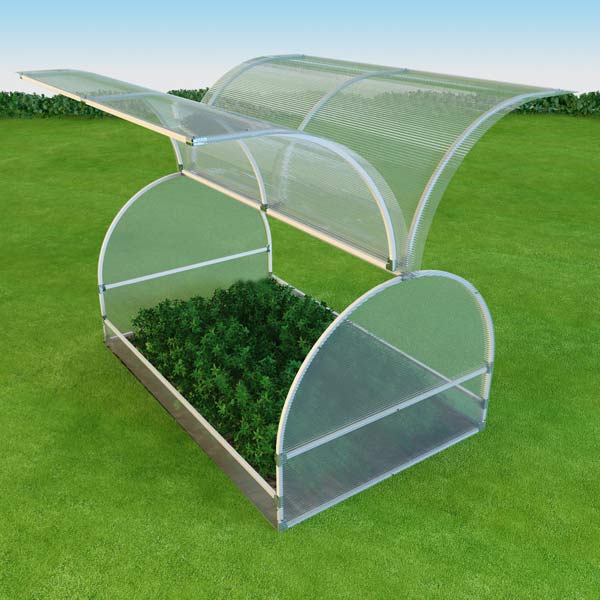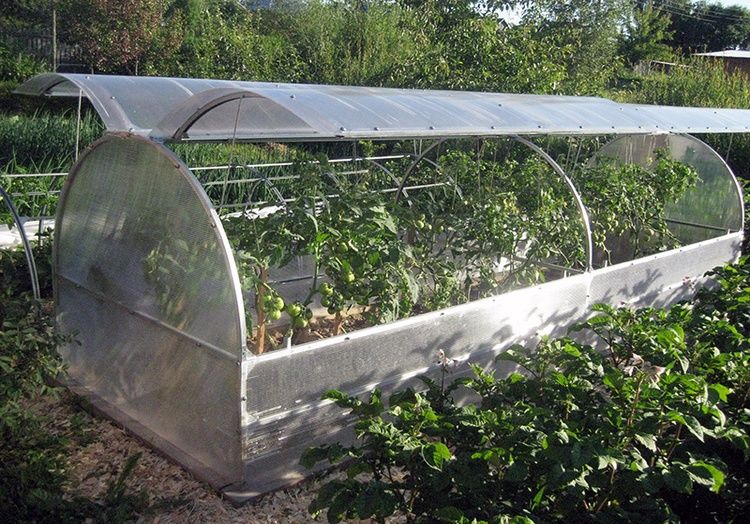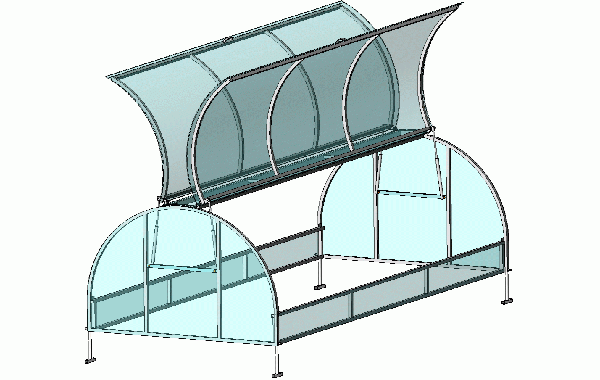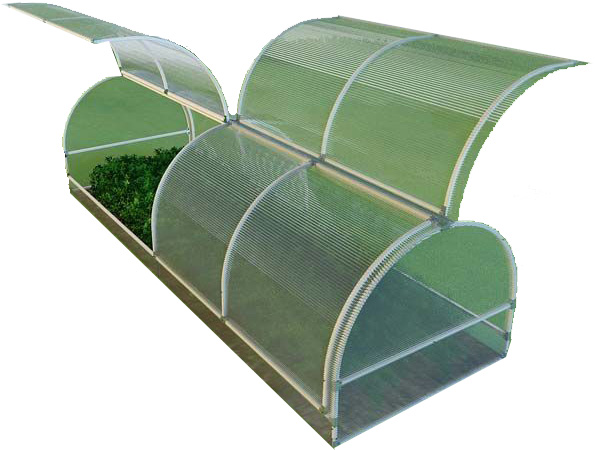How to build a polycarbonate butterfly greenhouse yourself
Content
The advantages of this design
Butterfly greenhouse made of high quality polycarbonate will be an excellent solution for every gardener. It is a gable structure, the area of which will be 100% used, since such a greenhouse is devoid of aisles. The standard dimensions of a butterfly greenhouse are 1.25 meters in length and width, up to 1.5 meters in height, and a total area of about 5 meters.

The frame is made of pipes measuring 2 by 2 cm, and the weight of the finished structure is 26 kg. The greenhouse for new generation cucumbers has a lot of undeniable advantages. It allows comfortable access to vegetable crops, since there is an entrance from both sides, and you can reach even remote places. Special gas lifts will help to avoid closures. Thanks to the vents, you can ventilate the butterfly greenhouse. Cellular polycarbonate provides reliable protection against sudden temperature fluctuations and exposure to ultraviolet rays.
The material has a higher degree of strength and at the same time is more flexible than the glass we are used to. With all its lightness, such a structure can withstand a layer of snow 10 cm thick and gusts of wind up to 20 m per second. The design of the butterfly greenhouse is easy to disassemble and assemble if necessary. The compact size allows the greenhouse to be moved in the car at any distance. The service life of such a structure is approximately 10 years. If you do not have the opportunity to build a spacious polycarbonate greenhouse, it doesn’t matter, because a construction measuring 2m by 4m will be useful and functional.
Choosing a place for a greenhouse

An important point is choosing a location suitable for installing a butterfly greenhouse. There are a few things to consider. The location of the cardinal points, therefore, the best option would be a site located in the direction from east to west. Seedlings require a lot of sunlight, which they need to receive in a day. The structure is positioned so that as much natural light as possible falls on it. The structure is installed in a place where a large amount of water will not accumulate. Do not allow the greenhouse to be heated by spring rain and melt water. Moisture can also come from neighboring household plots, as a result of which most of the vegetable crops suffer. The surface should be perfectly flat, no trees should grow on it. They place the structure in the immediate vicinity of the housing in order to conduct electricity to it.
Video "Homemade greenhouse for cucumbers and tomatoes"
Erection of the foundation
A butterfly greenhouse made of polycarbonate can be installed without a foundation. It will be required if in the future you do not plan to change the location of the structure. To create a foundation, you will need to mark the site, prepare a foundation pit up to 60 cm deep. Fill it with reinforcement and other metal elements.Fix the sides to the base. Install support posts made of metal or wood in the center of the building. Fasten the upper part of the greenhouse structure with posts, attach the frames with a piano loop to the upper part, install polycarbonate. Some experienced gardeners believe that a foundation is unnecessary. In practice, it will not hurt, you can also build it from wood or concrete.
Butterfly greenhouse installation

Installation diagram of polycarbonate fenders
You can buy a ready-made butterfly greenhouse for cucumbers or build it yourself. The best material for the base is wood; it is permissible to use pipes for the frame. The thickness of the sides, provided that a tree is used, should be at least 2.5 cm. The height of the structure will depend on the type of plant - at least 20 cm for melon, more for tomatoes and eggplant.
The width should be such as to be able to reach the middle of the building. The length is determined on an individual basis - it depends on the size of the site and your wishes. The construction of a polycarbonate building begins with the sides. You can make folding, single and double. They are adjusted so that there are no gaps. It is necessary to arrange solid beams along the component parts of the sides. Frames on metal hinges are attached to the surfaces of the boards. Corner joints are securely reinforced with metal parts.
Fixed open frames require a wooden support and anchoring it in width. A cord is attached to the structure, which will hold the frame on those days when the wind is strongest. It is recommended to install bucket hooks on the sides. For long-term operation of the building, wood material is advised to be treated with an antiseptic. In the place of contact of the base with the ground, it is recommended to place strips of old linoleum or regilin. The minimum size of such a structure on the site is 4m per pair.
Operating rules

If the weather is warm, the frame can be opened all day. With the onset of cold weather, the vegetation will be protected by light rack frames, which are covered with a film.
It is permissible to use a polycarbonate structure with double fasteners - from light and main frames. In this case, the inside will be better kept warm. And the period of planting seedlings of vegetables can be started 10 to 15 days earlier than the recommended dates. In the fall, if the building is used correctly, the harvest inside it will normally be preserved. To organize an irrigation system, there is no need to come up with something complicated - a simple watering can is enough.
When growing melons and gourds, it is necessary to install supports so that their whips do not fall on the ground. For the winter, the polyethylene is removed from the frames, washed and dried. Other materials are also washed. Before winter, the plants are removed from the building. The frame is cleaned so that pests do not appear, the soil is disinfected. If necessary, repair the frame without leaving it in the spring.
Video "Build a greenhouse butterfly"
In this video, everyone who wants to assemble the same greenhouse at home or in the country will be able to look at the work of professionals and learn useful nuances for themselves.
